All-Butter Flaky Pie Crust Recipe
This post may contain affiliate links, which means that I may receive a commission if you make a purchase using these links. As an Amazon Associate I earn from qualifying purchases.
This pie crust is made with butter for a flaky and tender pastry with a rich flavor that complements both sweet and savory fillings, including fruit, custard, cream, and meat and fish pies.
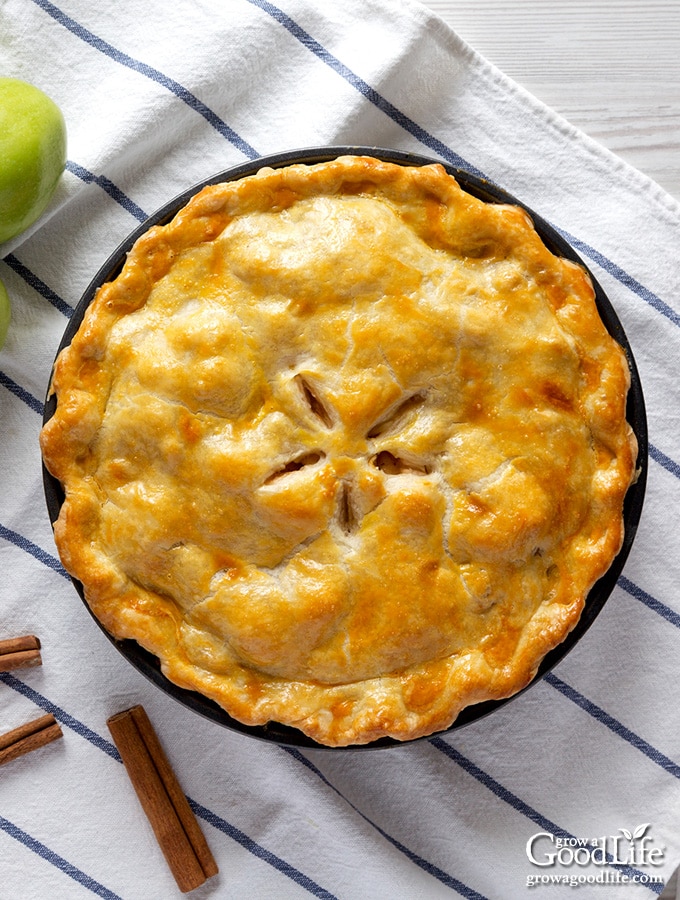
Everyone should have a basic pie crust recipe, whether it is an old-fashioned recipe passed down from your grandmother, or a classic recipe from the first cookbook you ever owned. This is my go-to, double crust all butter pie crust recipe.
Tips for a Flaky, Tender Pie Crust
Making a homemade pie crust doesn’t have to be difficult, just keep these tips in mind:
Mix the Dough by Hand
Yes, you can use a food processor to make things a little easier, and your pie crust will come out very tasty. However, if you want a truly flaky pastry, it is important not to overwork the dough.
For a flaky pie crust, you want small chunks of butter evenly throughout the dough. When the pie pastry is cooked, the butter chunks melt and heat up creating pockets in the flour. These pockets give the cooked pie crust its flakiness.
A food processor or mixer tends to break down the chunks of butter a little too much. By the time you add the ice water, most of the butter is already in small fragments and may even be partially melted from the blade. The pie crust will still taste good, but it won’t have the tender flakiness that the larger chunks of butter can achieve.
Freeze the Butter
I struggled for many years trying to cube butter into small pieces, add it to the flour, and combine it without melting. Even when using a pastry cutter, I had difficulty with the butter clinging together, and I always ended up with large, unevenly distributed chunks of butter in my pie dough.
Then I tried a tip I found online. Freeze the butter, and grate it with the large holes of a box grater.
Freezing the butter serves two purposes: First, it keeps the butter chilled so it won’t melt. Second, it creates the small chunks of butter at the size you want for a flaky pie crust.
Go ahead and grate your frozen butter right on top of your flour mixture. Pause and toss the grated butter several times so it is coated with flour, and then continue with grating the rest of the butter. Toss again to distribute the butter through the flour mixture, and begin adding your ice-cold water one tablespoon at a time.
Keep Everything Cold
Warm hands will melt the butter. Use a pastry blender, fork, or wooden spoon to combine your ingredients. Once the dough begins to come together and is too stiff to work, go ahead and use your hands to collect the dough together. Knead the dough several times, divide it into two even sized balls, flatten into disks, wrap in plastic or reusable beeswax wrap, and refrigerate right away to keep those butter chunks cold.
Use ice water. Warm water will also melt the butter. Fill a cup with water, and then add several ice cubes to the cup to keep the water very cold. Add your water to your pastry mixture a tablespoon at a time until the dough holds its shape.
How to Freeze Pie Crust
This pie pastry can be made ahead and frozen for later. Simply form the dough into a flat discs, wrap it tightly in beeswax or plastic wrap, place it into a freezer bag, and store in the freezer. Thaw the dough in the refrigerator the day before making your pie, and then you can roll and shape the pie crust like normal. For the best results, use frozen pie pastry within 2 months.
Pie Crust Glazing Options
A beaten egg brushed over the top crust will produce a nice light-brown glazed crust when baked.
A sugary crust is ideal for fruit pies. It adds a little sweetness and sparkle. Simply brush with egg, and sprinkle with granulated sugar before baking. If you prefer a shiny crust, brush the top crust with milk instead.
Steps for Making an All Butter Pie Pastry
A traditional pie crust is made from four simple ingredients, flour, fat, salt, and water. This recipe uses real butter for the fat, which gives the pastry lots of flavor and flakiness.
A full printable recipe can be found at the bottom of this article, but here are the illustrated steps for making a basic pie pastry. This recipe makes one double or two single pie crusts.
Step 1: Gather the Kitchen Equipment
- Large mixing bowl
- Pastry blender, fork, or wooden spoon
- Box grater
- Reusable beeswax wraps or plastic wrap
- Rolling pin
- Pastry mat or large cutting board
- Pastry brush
- Pie pan
Step 2: Prep the Ingredients
Measure and place the butter in the freezer for at least 30 minutes. Combine the flour and salt together in a large bowl. Fill a cup with ice and cold water.
Step 3: Make the Pie Dough
Grate your frozen butter over the flour mixture. Toss the grated butter several times to coat it with flour and prevent sticking.
Add about four tablespoons of ice water, mix with a pastry blender, fork or wooden spoon, and continue drizzling in ice water one tablespoon at a time until the dough holds its shape.
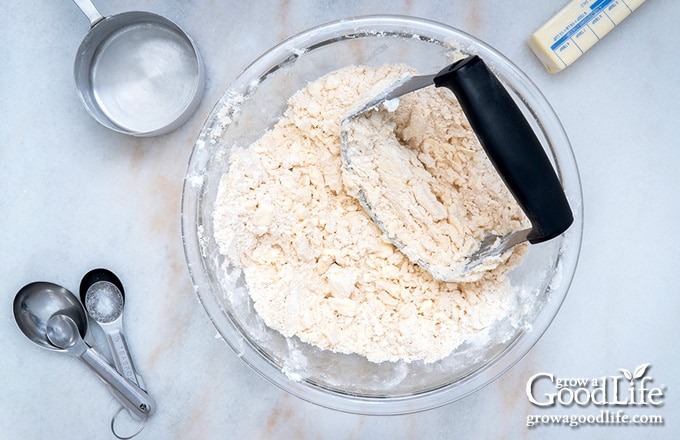
Using your hands, divide the dough into two even sized balls, and flatten into disks. Wrap each disk and chill the dough until you are ready to use it. Make your pie filling of choice while the pie crust is chilling.
The pie crust can be frozen at this time. See How to Freeze Pie Crust above.
Step 4: Make the Pie
Remove the pie pastry from the refrigerator and let it warm for 10 minutes before rolling.
While the dough is warming, generously flour your cutting board or pastry mat with flour. Place a disk in the center, flour the top and your rolling pin, and begin rolling from the center outward. Lift and turn the pastry occasionally to help keep it even. Dust with flour as needed to prevent sticking. Continue rolling from the center into a circle to fit your pie plate.
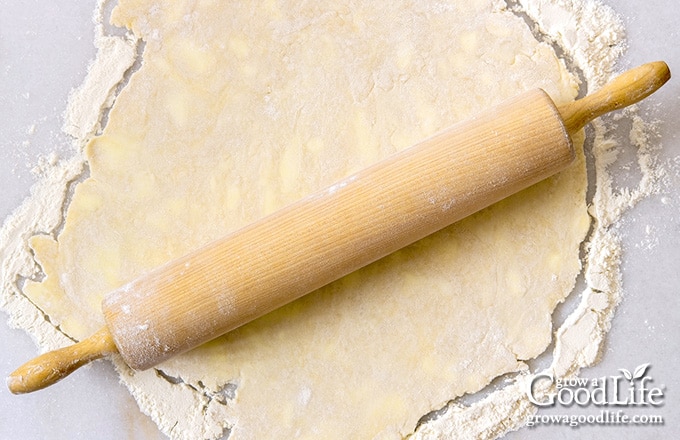
Place the pastry into the pie plate and add the filling. Brush around the outer edge of the pastry with the beaten egg using your fingers or pastry brush.
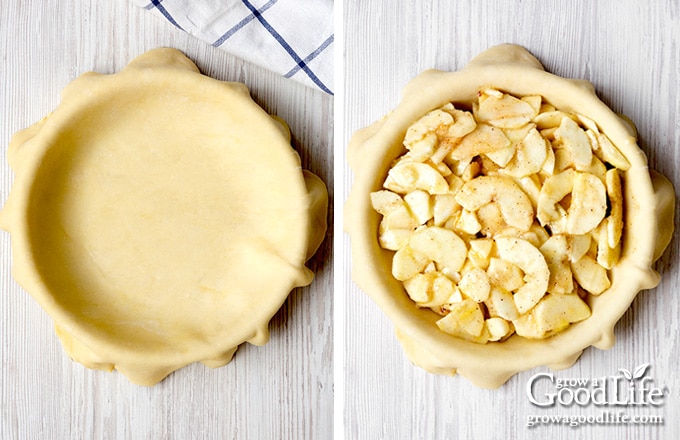
Roll out the top pastry and place on top of the filling. Fold the top crust under the bottom crust and seal the edges. Brush the pie with beaten egg and sprinkle with sugar (if desired). Cut vent holes and bake in a preheated oven according to your recipe. This recipe makes one double or two single pie crusts.
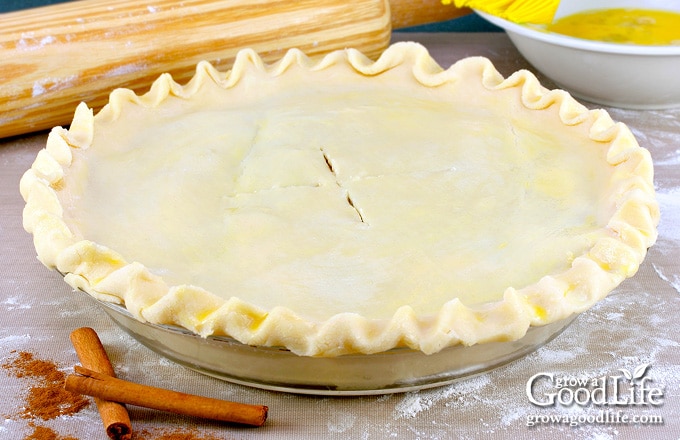
How to Make a Lattice Top Pie Crust
A woven lattice top pie not only looks pretty, but also the open weave allows the steam to escape as the pie bakes. This is especially helpful for fruit pies that will bubble quite a bit as they cook. Here is how you can easily weave a lattice top for a nice rustic pie:
Roll out the top pastry into a rough circle about two inches wider than the pie plate. Cut the dough into 1-inch wide ribbons using a sharp knife or pizza cutter. I use a ruler to help keep the cuts straight and the strips the same size.
Lay the horizontal strips on the pie spaced out evenly. Fold every other strip back, and lay a vertical strip across. Return the horizontal strips, and fold back the alternative strips. Lay another vertical strip across. Continue alternating in an over and under pattern.
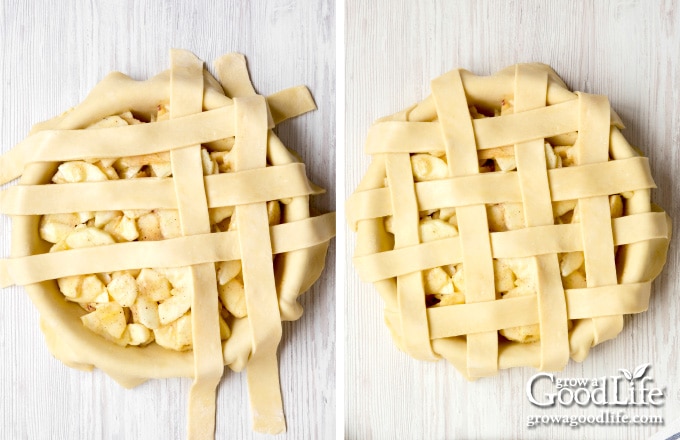
Trim off any extra dough, flip the bottom crust over the lattice strips, and pinch to crimp the dough together and make a decorative edge. Brush the pie with a beaten egg, sprinkle with sugar, and bake according to your recipe.
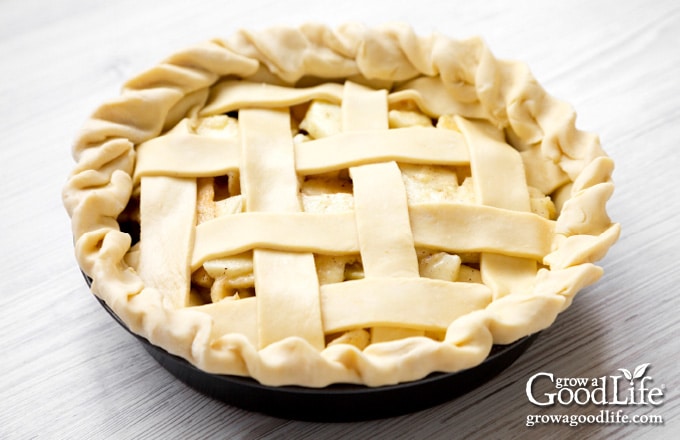

All-Butter Flaky Pie Crust Recipe
Ingredients
- 2 cups unbleached all-purpose flour plus more for dusting
- 1/2 teaspoon kosher salt
- 2/3 cup unsalted butter frozen
- 6-7 tablespoons ice cold water
- Pie filling of choice
- 1 beaten egg for the glaze optional
Instructions
- In a large bowl, combine flour with the salt.
- Grate the frozen butter on top of the flour mixture, and toss until the butter is evenly distributed.
- Stir in 4 tablespoons of the ice water. Then add additional ice water, 1 tablespoon at a time, stirring until the dough starts to clump together.
- Divide and shape the pie dough into two discs, wrap, and chill in the refrigerator. While pastry is chilling, prepare the filling.
- Preheat your oven according to your recipe.
- Remove the chilled pie pastry from the refrigerator.
- On a lightly floured surface, flatten one ball of dough with your hands. Using a rolling pin, roll the dough to fit your pie plate, about 12-inches in diameter.
- Place the pastry into the pie plate carefully without stretching the dough. Add the filling, and brush around the outer edge of the pastry with water or the beaten egg.
- Roll out the top pastry and place on top of the filling. Fold the top crust under the bottom crust and pinch or flute the edges.
- Glaze by brushing with the beaten egg if desired. If you prefer a shiny crust, brush with milk. If you want a sugary crust, brush with egg and sprinkle with granulated sugar. Cut vent holes.
- Following your pie recipe, bake in a preheated oven until the pastry is golden brown.
- Remove the pie from oven and let it cool at least 30 minutes before serving.
- Makes 1 pie, about 8 servings.
Nutrition
You May Also Like:
Good planning is key to a successful vegetable garden
Whether you are new to growing your own food or have been growing a vegetable garden for years, you will benefit from some planning each year. You will find everything you need to organize and plan your vegetable garden in my PDF eBook, Grow a Good Life Guide to Planning Your Vegetable Garden.


The top crust came out amazing, flakey and golden, but like another comment I read here, as the pie was baking at 425 I could see butter boiling all along the bottom and sides, the cherry pie filling did not leak. I thought well that’s nice, it will be like fried crust, but no, once it cooled it was impossible to cut it was so tough. I did not overwork it as I know that’s a no-no, what did I do wrong?
Tracy, I’m so glad the top crust turned out flaky and golden! It sounds like the butter may have melted too quickly, or the filling may have released extra moisture, making the bottom crust tough. Here are a few things to try:
1. Chill the Dough Well – Ensure the pie dough is very cold before baking to keep the butter from pooling.
2. Preheat the Oven Fully – A properly preheated oven helps set the crust before the butter melts.
3. Check the Filling – If the cherry pie filling was extra juicy, it may have soaked into the crust. Try thickening it a bit more before baking. Additionally, if the filling was too hot when filling the crust, it may have melted the butter.
I hope this helps! Let me know if you try again.
The crust was buttery, flaky, light and totally epic. Thank you for an excellent recipe…for once the mother in law did not insult my cooking. I kept tapping on the rating stars but nothing happened…it’s a 5/5 in my kitchen. The best!
Maggie, Thank you so much for your feedback! I’m thrilled to hear that you loved the crust and that it impressed even your mother-in-law! Your kind words mean a lot, and I’m glad the recipe worked out so well for you.
I haven’t used your recipe, yet. But I plan to! My last pie crust had a chewy texture to it (would prefer the crumbly flaky texture described here), any ideas what would cause that? Can’t wait to try this one out!
Nicole, I’m excited for you to try the recipe! A chewy texture in a pie crust can sometimes be attributed to overworking the dough. With this recipe, try handling the dough gently and just until it comes together. Also, make sure your butter is very cold and that you’re using ice water. I hope you achieve that perfect crumbly, flaky texture you’re aiming for!
I have never been successful in making homemade pie crust until I tried your tips. Thank you.
I have saved this recipe as it was a crowd pleaser!
Susan, I’m so happy you found the tutorial helpful and had great success making pie crust with this recipe.
When the pie was cookie, butter was boiling at the around the bottom of the pie plate. Will it be edible? Soggy bottom?
Kathy, Sorry to hear you’re having trouble! It’s unusual for butter to boil around the pie plate. Is the boiling liquid pie filling bubbling over or through breaks in the pastry? If so, then you may end up with a soggy crust. However, it is still edible.
What temp should I preheat the oven?
Madison, The temperature to preheat your oven will depend on the specific pie recipe you’re making. Different pie fillings may require different baking temperatures. I’d recommend checking your pie recipe for the recommended baking temperature. It should specify what temperature to preheat the oven to.
Was not enough for a 8” double crust pie
Very disappointing. Won’t be making this again
Ginger, I’m sorry to hear that the recipe didn’t work as expected for your 8-inch double crust pie. This recipe is for two 9-inch pie crusts, so it’s possible that there might have been an issue with the measurements or rolling out the dough. If you decide to try it again, you might want to double-check your measurements and ensure the crust is rolled out sufficiently to fit your pie dish. I hope your next attempt is more successful.